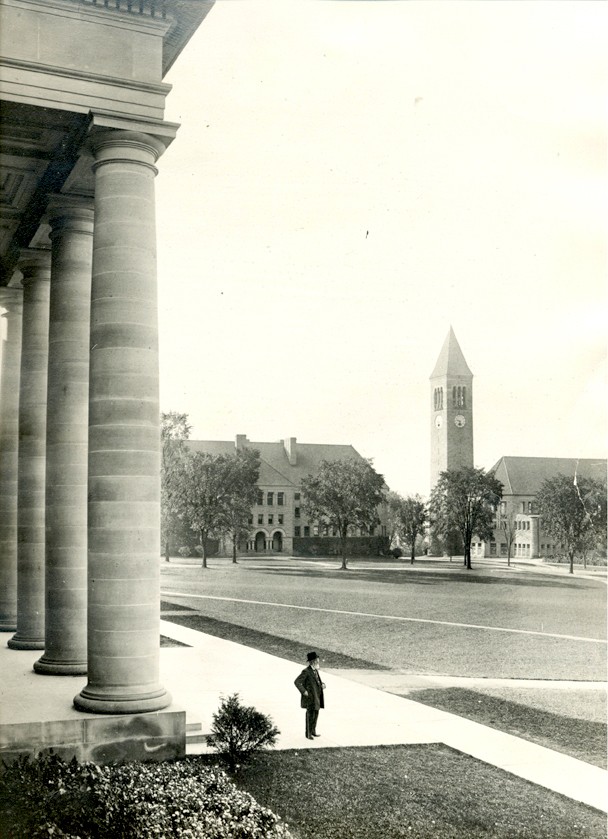Cornell sustains presidential ties to Univ. of Michigan
By Blaine Friedlander
With the selection of Martha E. Pollack as Cornell’s 14th president, the university has chosen five of its last six leaders from Big Ten schools.
It is fitting, then, that Isaac Kramnick, the Richard J. Schwartz Professor of Government and a member of the Presidential Search Committee, described Cornell to Pollack as “an Ivy League university with a Big Ten heart.”
“As someone who was educated at Dartmouth and Penn, but who has spent the last 16 years at a Big Ten university, the University of Michigan, I understood exactly what he meant,” said Pollack, Michigan’s provost and executive vice president for academic affairs, at the Nov. 14 press conference announcing her selection.
Big Ten by the numbers: Eight of Cornell’s 14 presidents have ties to the Big 10. Six (Andrew Dickson White, Charles Kendall Adams, Edmund Ezra Day, Frank H.T. Rhodes, Jeffrey Lehman and Pollack) had been either faculty members or deans at Michigan. Two (Hunter Rawlings and David Skorton) had served as president of the University of Iowa.
The Cornell-Michigan link started years before Cornell opened its doors.
White, the university’s first president (1866-1885), was a professor of history and literature at the University of Michigan from 1857 to 1863. He left Michigan to attend to family matters in Syracuse, travel to Europe to secure support for the Union, and then became a New York state senator. He met Ezra Cornell while they both served in the New York State Senate and worked together to create the state’s land-grant university. White officially resigned in 1867 from Michigan’s faculty to become Cornell’s president.
As the first students entered Cornell in 1868, White emulated practices of Michigan’s first president, Henry Philip Tappan, such as hiring faculty based on qualifications in their field of study. Traditionally, universities had hired professors based on religious affiliation. In “A History of Cornell,” historian Morris Bishop wrote: “White learned a great deal in Michigan … He accepted Tappan’s conception of a university … He was impressed by the system of visiting university lecturers. These included such men as Ralph Waldo Emerson, [abolitionist] Wendell Phillips, [Union Gen.] Carl Schurz and [orator] George William Curtis.”
Adams had been a student under White at Michigan and served on Michigan’s faculty until 1885, when he assumed the Cornell presidency (1885-92) after White stepped down. Cornell’s fifth president (1937-49), Day, earned a bachelor’s from Dartmouth in 1905 and served on the economics faculty at Michigan.
Rhodes, Cornell’s ninth president (1977-95), joined the Michigan faculty in 1968 as a geology professor and was appointed dean of the College of Literature, Science and the Arts in 1971. “His classes were major hits with students,” a faculty colleague at Michigan told the Cornell Alumni News in 1977. “He’s always in demand as a speaker, both for his smooth delivery and for what he has to say.”
A Michigan faculty member suggested Rhodes for the Cornell presidency to Robert Purcell ’32, then-chair of Cornell’s board of trustees. “Frank H.T. Rhodes took the various presidential selection committees by storm, which both simplified and complicated the search process,” according to the Alumni News. “People who had met him suddenly put him at the top of their list.”
Lehman ’77, Cornell’s 11th president (2003-06), earned his J.D. from Michigan in 1981 and served as dean of its law school. Pollack, who will become Cornell president April 17, 2017, has been on Michigan’s computer science faculty since 2000.
All of the Big Ten universities are major, national research institutions comprising multiple colleges with numerous academic disciplines. “Cornell is an elite Ivy League private university with a very public land-grant mission,” said Rawlings, during Skorton’s inauguration in 2006. “And that makes the Big Ten a natural place from which to draw leaders.”
Media Contact
Get Cornell news delivered right to your inbox.
Subscribe